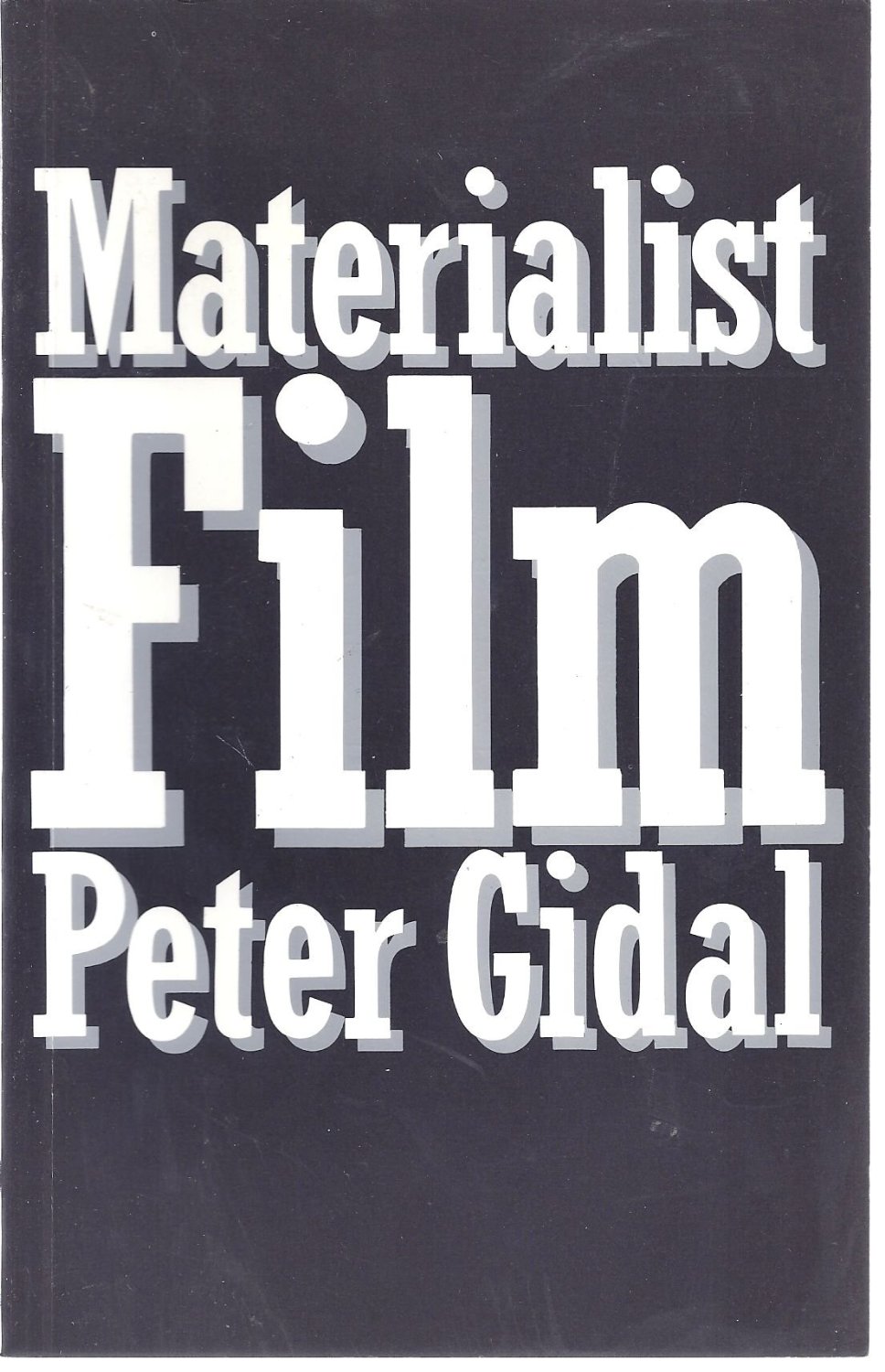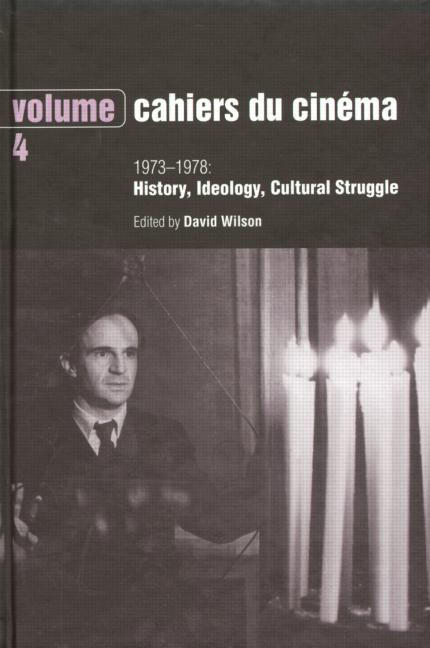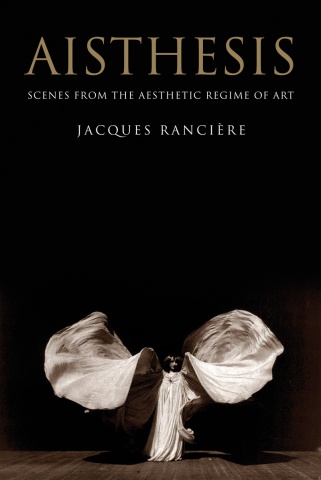Peter Gidal: Materialist Film (1989)
Filed under book | Tags: · abstraction, aesthetics, avant-garde, bourgeoisie, cinema, experimental film, film, film history, ideology, illusion, image, meaning, narrative

“A polemical introduction to the avant-garde and experimental in film (including making and viewing), Materialist Film is a highly original, thought-provoking book.
Thirty-seven short chapters work through a series of concepts which will enable the reader to deal imaginatively with the contradictory issues produced by experimental film. Each concept is explored in conjunction with specific films by Andy Warhol, Malcolm LeGrice, Lis Rhodes, Jean-Luc Goddard, Rose Lowder, Kurt Kren, and others.
Peter Gidal draws on important politico-aesthetic writings, and uses some of his own previously published essays from Undercut, Screen, October, and Millennium Film Journal to undertake this concrete process of working through abstract concepts.”
Publisher Routledge, 1989
ISBN 0415003822, 9780415003827
189 pages
via maxp
Review: Wheeler Winston Dixon (Prairie Schooner, 1990)
PDF (10 MB, updated on 2016-12-24)
Comment (0)Cahiers du Cinéma, vols. 1–4 (1951–78/1985–2000) & Special Issues in English (1966-67)
Filed under book, magazine | Tags: · aesthetics, cinema, film, film criticism, film history, film theory, philosophy of film




Cahiers du Cinéma [Notebooks on Cinema] is an influential French film magazine founded in 1951 by André Bazin, Jacques Doniol-Valcroze and Joseph-Marie Lo Duca. It developed from the earlier magazine Revue du Cinéma involving members of two Paris film clubs—Objectif 49 (Robert Bresson, Jean Cocteau and Alexandre Astruc, among others) and Ciné-Club du Quartier Latin. Initially edited by Éric Rohmer, it included amongst its writers Jacques Rivette, Jean-Luc Godard, Claude Chabrol and François Truffaut. (from Wikipedia)
This set of four volumes presents selected texts from the years 1951-1978 in English translation.
Cahiers du Cinéma: The 1950s: Neo-Realism, Hollywood, New Wave
An anthology from Cahiers du Cinéma, nos 1–102, April 1951 – December 1959
Edited by Jim Hillier
Publisher Harvard University Press, 1985
ISBN 0674090608
312 pages
Cahiers du Cinéma: 1960-1968: New Wave, New Cinema, Reevaluating Hollywood
An anthology from Cahiers du Cinéma, nos 103–207, January 1960 – December 1968
Edited by Jim Hillier
Publisher Harvard University Press, 1986
ISBN 0674090624
363 pages
Cahiers du Cinéma, Volume 3: 1969-1972: The Politics of Representation
An anthology from Cahiers du Cinéma, nos 210–239, March 1969 – June 1972
Edited by Nick Browne
Publisher Routledge, in association with the British Film Institute, 1990
ISBN 0415029872
352 pages
Cahiers du Cinema, Volume 4: 1973-1978: History, Ideology, Cultural Struggle
An anthology from Cahiers du Cinéma, nos 248–292, September 1973 – September 1978
Edited by David Wilson
With an Introduction by Bérénice Reynaud
Publisher Routledge, in association with the British Film Institute, 2000
ISBN 0415029880
323 pages
Publishers: Volume 1, Volume 2, Volume 3, Volume 4.
Volume 1 (1950s)
Volume 2 (1960-1968)
Volume 3 (1969-1972)
Volume 4 (1973-1978)
Cahiers du Cinema in English, ed. Andrew Sarris:
Number 1 (Jan 1966, 74 pp, 57 MB, via chef, added 2015-1-11),
Number 2 (Mar 1966, 82 pp, 65 MB, via chef, added 2015-1-12),
Number 3 (May 1966, 74 pp, 63 MB, via chef, added 2015-1-16),
Number 4 (Jul 1966, 66 pp, 57 MB, via chef, added 2015-1-16),
Number 5 (Sep 1966, 65 pp, 56 MB, via chef, added 2015-1-16),
Number 6 (Dec 1966, 66 pp, 57 MB, via chef, added 2015-1-16),
Number 7 (Jan 1967, 66 pp, 61 MB, via chef, added 2015-1-16),
Number 8 (Feb 1967, 68 pp, 44 MB, via LtJ),
Number 9 (Mar 1967, 65 pp, 59 MB, via chef, added 2015-1-17),
Number 10 (May 1967, 68 pp, 43 MB, via LtJ),
Number 11 (Sep 1967, 68 pp, 43 MB, via LtJ)
Number 12 (Dec 1967, 66 pp, 60 MB, via chef, added 2015-1-18)
See also: Daniel Fairfax: The Red Years of Cahiers du cinéma, 1968-1973 (2021).
Comments (5)Jacques Rancière: Aisthesis: Scenes from the Aesthetic Regime of Art (2011/2013)
Filed under book | Tags: · aesthetics, art, art history, art theory, body, cinema, dance, film, life, literature, music, painting, pantomime, philosophy, photography, poetry, politics, representation, sculpture, theatre, theory

Rancière’s magnum opus on the aesthetic.
“Composed in a series of scenes, Aisthesis–Rancière’s definitive statement on the aesthetic–takes its reader from Dresden in 1764 to New York in 1941. Along the way, we view the Belvedere Torso with Winckelmann, accompany Hegel to the museum and Mallarmé to the Folies-Bergère, attend a lecture by Emerson, visit exhibitions in Paris and New York, factories in Berlin, and film sets in Moscow and Hollywood. Rancière uses these sites and events—some famous, others forgotten—to ask what becomes art and what comes of it. He shows how a regime of artistic perception and interpretation was constituted and transformed by erasing the specificities of the different arts, as well as the borders that separated them from ordinary experience. This incisive study provides a history of artistic modernity far removed from the conventional postures of modernism.”
First published as Aisthesis : Scènes du régime esthétique de l’art, Éditions Galilée, 2011
Translated by Zakir Paul
Publisher Verso Books, 2013
ISBN 1781680892, 9781781680896
304 pages
via falsedeity
Reviews: Hal Foster (London Review of Books), Joseph Tanke (Los Angeles Review of Books), Marc Farrant (The New Inquiry), Ali Alizadeh (Sydney Review of Books), Jean-Philippe Deranty (Parrhesia).
Roundtable discussion with Rancière at Columbia (video, 43 min)
Selected interviews and reviews (in French)

